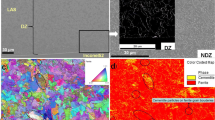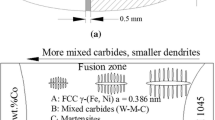Abstract
This study was conducted on a fusion-welded specimen of Ti-6Al-2Nb-1Ta-0.8Mo to identify the cause of extensive cracking and porosity observed in the weld. Localized interstitial element measurements by nuclear reaction analysis techniques established that various regions in the weld and the base metal contained undesirably high concentrations of oxygen, carbon and hydrogen. A 5μm thick surface layer of the as-received base metal, found to be rich in oxygen (16 000 w.p.p.m.), carbon (2700 w.p.p.m.), and hydrogen (425 w.p.p.m.), could have led to the multitude of weld defects observed in this work. In the weld and heat-affected zone, the hydrogen and carbon concentrations near various defects, such as cracks and porosity, were considered normal (i.e. ∼50 w.p.p.m. and 160 w.p.p.m., respectively). There were high oxygen concentrations (∼3000 w.p.p.m.) near weld defects, which were two to three times higher than unwelded base metal. A direct correlation between oxygen content and microhardness showed that crack defect regions were characterized by both high oxygen and hardness, thereby indicating that oxygen played a major role in causing embrittlement and subsequent cracking.
Similar content being viewed by others
References
M. D'andrea,Welding J. 45 (1966) 178S.
D. Mitchell,ibid. 44 (1965) 157S.
R. Evans, “Porosity in Titanium Welds”, DMIC Memorandum 194 (Battelle Memorial Institute, Columbus, Ohio, 1964).
W. Baeslack, D. Becker andF. Froes,J. Metals 36 (1984) 46.
J. Gordine,Welding J. 53 (1974) 117.
G. Padawer, US Patent 3710113, Lithium Nuclear Microprobe, 9 January (1973).
P. Adler, E. Kamykowski andG. Padawer, “Localized Hydrogen Measurements in Surfaces Using the Lithium Nuclear Microprobe”, Hydrogen in Metals (American Society for Metals, Metals Park, Ohio, 1974) p. 623.
E. A. Kamykowski, F. J. Kuehne, E. J. Schneid andR. L. Schulte,Nucl. Inst. Meth. 165 (1979) 573.
R. L. Schulte,ibid. 137 (1976) 251.
G. Petrov andA. Khatuntev,Welding Production 22 (1975) 81.
P. Adler, J. Kennedy andF. Satkiewitz,Welding J. 52 (1973) 180S.
F. Kulikov,Welding Production 22 (1975) 37.
Author information
Authors and Affiliations
Rights and permissions
About this article
Cite this article
Kennedy, J., Schulte, R. Localized interstitial element analysis in defect regions of a near alpha titanium alloy fusion weld. J Mater Sci 21, 4424–4430 (1986). https://doi.org/10.1007/BF01106566
Received:
Accepted:
Issue Date:
DOI: https://doi.org/10.1007/BF01106566




